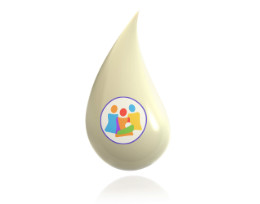Latching Well
Updated 01/25
PDF Version
Latching the baby well will help establish a comfortable direct feeding relationship with good milk removal by baby. A poor latch can result in difficulty with milk transfer, nipple pain during feeding, and low infant weight gain.
Tips on Getting a Good Latch
- Look for early feeding cues to start a feed (or after 2-3 hours if baby does not cue to feed).
-
- For newborns, this includes stirring in their sleep, licking their lips, smacking or sucking their fist.
- Do not wait for your baby to start crying before you put your baby to your breast. If your baby is crying or upset, you will need to calm your baby down. The skin-to-skin position helps to calm your baby and organize the baby to latch well. Skin-to-skin means holding your baby close to you, chest to chest, while you and the baby are not clothed above the waistline. When the baby is held skin to skin, the baby will calm, then begin rooting, or looking for the breast. The baby will move towards one breast, and by using her facial cheeks to find the nipple, the baby will naturally latch to the breast. You will need to guide the baby to the breast, so that the baby does not fall. Skin-to-skin contact also helps stimulate your hormones and promotes milk letdown.

- Position yourself and your baby comfortably using pillows as needed. See the Positioning to Help Your Baby Latch Well handout.
- Support your breast with one hand, while using your other hand and arm to support the base of the baby’s head, behind the ears and upper back. Avoid pushing the back of the baby’s head.
- Put slight pressure on the upper portion of the breast so that the nipple points upward.
- Touch the baby’s nose or upper lip with your nipple, resting the underside of the nipple/areolar region again the chin, and wait for them to open their mouth wide.


- When your baby opens their mouth wide, allow the nipple to flip down into the baby’s mouth.
- Baby should latch on deeply. Signs of a deep latch include:
-
- Mouth is wide open
- You can see the lower lip relaxed and a little ‘flipped out’
- the upper lip is relaxed on the upper portion of the breast (it does not ‘flip out’)
- The nose is very close or touching the breast
- You do not have pain
- You can hear sucks and swallows, while feeling a gentle tug


-
- As your baby suckles, their tongue extends and cups your breast tissue, drawing your nipple and areolar tissue deep in to her mouth.
- It is very common to have discomfort with initially latching your baby for the first few weeks, as you and your baby become more practiced.
-
- However, if your baby’s latch feels pinchy or painful throughout the feeding, break the latch with your finger inserted into the corner of your baby’s mouth, remove the baby from the breast and start over. A proper latch should not pinch or hurt during feeding.
Self-Attaching Baby
Some babies may prefer to latch from a skin-to-skin position. When newborns are placed skin-to-skin immediately after birth, they instinctually find their way to the breast. Babies retain this instinctual skill during the first year.
How do you allow baby to self-attach?
- Recline back on a bed, couch, chair or recliner, about ½ way to a lying position.
- Hold your baby chest to chest while you and the baby are not clothed above the waistline.
- With time, your baby will start bobbing their head, looking for the breast.
- Allow the baby to move to one side and down to a breast, while supporting the baby so they don’t fall.
- Give the baby room to nuzzle the breast/nipple, and to lift their head while opening their mouth wide to latch.
- Watch this YouTube video on self-led latch.
What to Expect During a Feed
- In the first few days (until your colostrum changes into milk), you may not hear many swallows at the breast. Milk usually “comes in” or starts increasing in volume around day 3-5. Certain medical conditions or interventions can delay this slightly.
- As your breasts become heavier with more milk volume, you will notice that your milk flow is intermittent, not continuous. This means that the milk flows during ‘let-downs’, which are periods of time when the milk is being ejected from your breasts. Many women notice that there are a few minutes between each letdown. Babies often finish feeding from the breast, and the breast feels soft, after 2-3 letdowns. You will know when you are having a let-down when your baby has a series of swallows. Sometimes the baby may cough or stop feeding momentarily when the milk is flowing fast. You might also notice a tingly or tight sensation in your breast during a letdown, but not everyone feels this.
- After your baby has been feeding for a while, your baby may let go of the breast or fall asleep. For newborns, wake the baby up by gentle touch or changing a diaper, then offer the other breast.
Additional Pointers
- Have patience. You cannot feed a baby who isn’t ready or willing to feed.
- Be flexible. Sometimes more stroking of the baby’s lips or just changing positions will make a difference so that baby is more receptive to feeding. You may also express drops of breastmilk so that the baby feels and tastes milk at the time of latching.
- Try to avoid pacifiers as you establish your milk production. Anytime your baby wants to suck, offer the breast rather than a pacifier. Avoid a pacifier until breastfeeding is going well, and the baby is gaining weight appropriately.
- Limit frustration for you and the baby. If a latch does not occur before the baby becomes upset, feed your baby some pumped milk using a bottle, cup, syringe, or finger feeding. After the baby has calmed, try to latch the baby again. If the baby will not latch, finish the feeding and start anew next time. Attempting to latch when the baby is not overly hungry enhances latch success.
- For infants who refuse to latch, try taking a warm bath with your baby on your chest, skin-to-skin. Let the baby nuzzle and lick at the nipple. A very relaxed baby in a skin-to-skin position will often use her natural feeding reflexes to find the breast and in the self-attachment section above.
- Believe in your baby. Although latching can be frustrating at times, your baby will improve her skills over time. Just as she is maturing in other ways, such as cooing and smiling, her latching skills will mature as well.
- Finally, if there is a problem – get help! Asking for help from an experienced lactation specialist can prevent many problems and help make latch easier and more comfortable.


